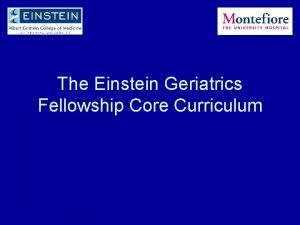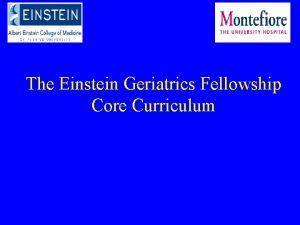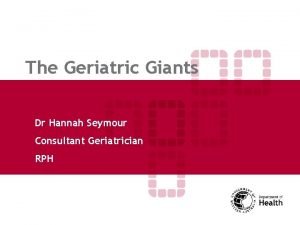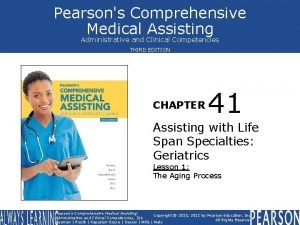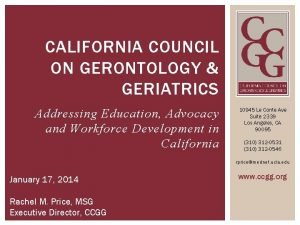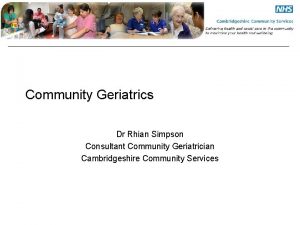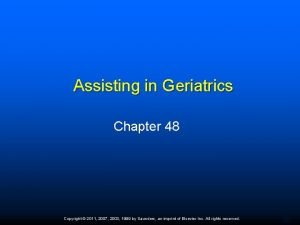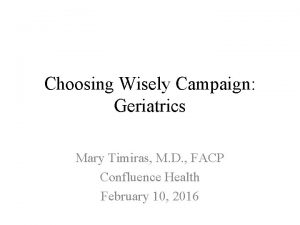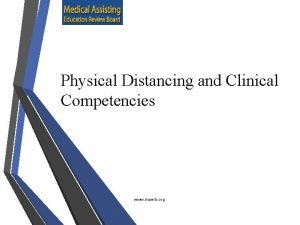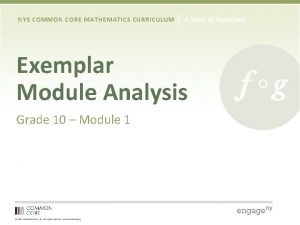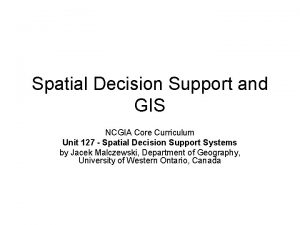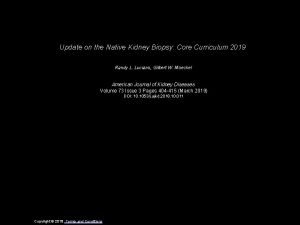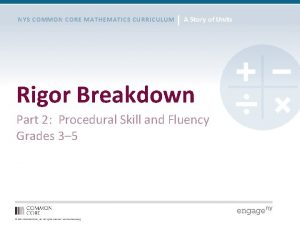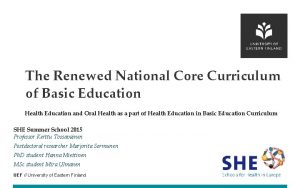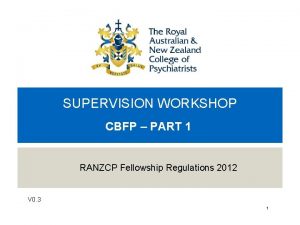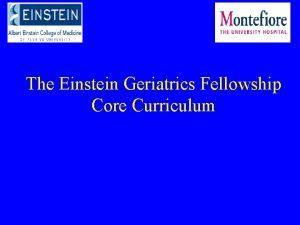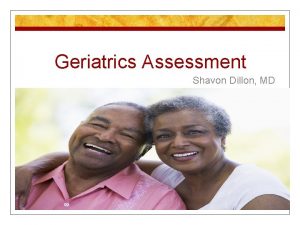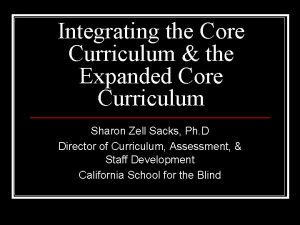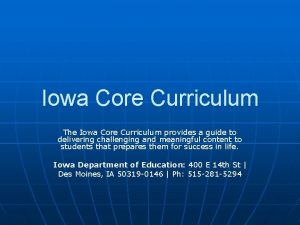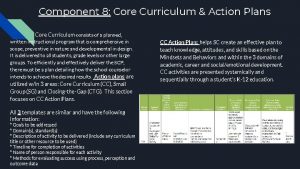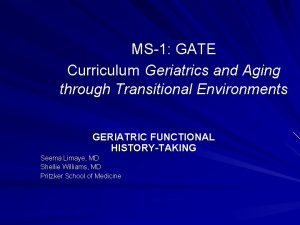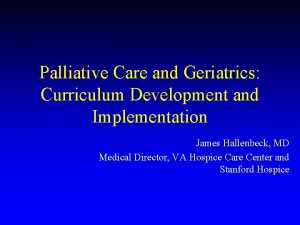The Einstein Geriatrics Fellowship Core Curriculum The Einstein














































- Slides: 46

The Einstein Geriatrics Fellowship Core Curriculum

The Einstein Geriatrics Fellowship Core Curriculum • A 20 part lecture series designed for first year geriatrics fellows • Covers the ACGME content areas for fellowship training

Introduction to Medicare, Medicaid and Community Services Amy R. Ehrlich, MD Debra Greenberg, Ph. D, MSW Division of Geriatrics Albert Einstein College of Medicine Montefiore Medical Center

Objectives 1. Describe the benefits available to older adults through Medicare part A, B, D in the outpatient, inpatient and LTC setting. 2. Understand the Medicaid income requirements and available benefits. 3. Recognize 2 -3 additional community services available to older adults.

Case-1994 • Mrs. R is a 75 yr. old African American female • Active medical problems: – Mechanical mitral valve for which she is anticoagulated – OA of the hips – Macular degeneration Image: www. bandwidthonline. or g © Annie Levy, 2008

• SH: Widowed. Retired secretary for a state agency. She lives in a town-house that she owns. Her son and his family live nearby. • Finances: – $2, 000 /month from a pension and SS – $200, 000 savings • She is currently managing well in the community. She is active in her church and attends cultural events with her friends.

Advancing Age: Functional Decline and Dependency • Dementia • Functional disability • Sensory impairment

Disability in Community Dwelling Older Adults AGE 80 60 -69 70 70 -74 Percent 60 50 75 -79 40 80+ 30 20 10 0 Any Disability Severe Disability Needs Assistance US Census Bureau 2000

Activities of Daily Living (ADL) • Feeding • Bathing • Toileting • Transferring • Dressing Instrumental Activities of Daily Living (IADL) • Cooking • Cleaning • Laundry • Shopping • Telephone & transportation • Managing medicines • Managing money

Advancing Age Increased functional decline Increased cognitive decline Sensory impairment Increased dependency

MEDICARE & MEDICAID Image: www. oheweb. com/images/flags/dsc 01186.

Medicare • Federal program • Eligibility: – Age > 65 – U. S. citizen or a permanent resident – Lived in the U. S. continuously for a five-year period – Worked for > 10 year period (or had spouse or child who worked) Image: www. seniorhelpforum. com

Medicare • • Part A-Hospital Insurance Part B-Medical Insurance Part C- Medicare Advantage “private insurance” Part D-Prescription Drug Coverage

Medicare Part A: Hospital • Deductible: $1, 132/year • Co-payments: – Hospital day 1 -60 – Hospital day 61 -90 – Hospital day 91 -150 – Each day beyond 150 Fully covered $283/day $566/day No coverage

Maximum Minimum Medicare Part B Medical Insurance Premiums INCOME/yr. PREMIUM/yr. Individual < $82, 000 $1, 150 Couple <$170, 000 Individual >$210, 000 Couple >$430, 000 $3, 700

“Medi-Gap” Insurances & HMOs • Additional insurance that covers “gap” between what Medicare pays and cost of services or • Capitated services that assign a “gatekeeper” physician

Medicare Part B • Office visits • 80% (20% co pay) • Lab tests • 100% • Diagnostic tests (CT, MRI) • 80% (20% co pay)

Medicare Coverage • Transportation • Emergencies • Hospital to SNF • Hearing aids • Eye glasses • Dental • Not covered • Post-operative-80 % • Not covered

Medicare HA Coverage • Long term HA • Short term HA

Medicare HA Coverage • Long term HA • Not covered • Short term HA • With skilled need- up to 20 hrs/wk.

Medicare Sub-Acute Rehabilitation • Sub-Acute Rehab • up to 20 days-100 % • 21 -100 days-$141. 50/day • >100 days-no coverage

Long Term Care = Nursing Home • No Coverage Image: eldercareabcblog. com

Hospice • Terminally ill with a prognosis < 6 months. • Patient choose to receive care from a hospice • Essentially all costs of terminal illness are covered including medications, transportation, home aids (20 hrs/week), inpatient respite care, bereavement services

Medicare Part D Prescription Plan • • • Mandated in 2006 Monthly premium/ co-pay vary Multiple different plans/ formularies in some states Plans and formularies change annually Coverage: – – 75% of cost: $2, 500 No coverage: $2, 500 -$5, 700 “ Donut Hole” 100% of cost > $5, 700 State programs and Medi. GAP plans may cover the donut hole. Image: businesspundit. com

Medicaid • State program based on poverty level • Benefits vary dramatically from state to state • Two categories of eligibility: – Age > 65 or < 18 years old – Or on Public Assistance Image: health. state. ny. us

Medicaid Eligibility-NY • Income limit – Individual: $767/month – Couple: $1, 117/month • Resource limit – Individual: $13, 800 – Couple: $20, 100 – Exemptions: $1, 500 person for burial fund, home, car, health insurance premiums. – Can continue in your own home but home is an asset. • 5 year “look-back”

Spousal Allowance-NY • Community spouse allowances when other spouse is institutionalized: SPOUSE • Income: • Resources: $2, 739/mo $109, 560

Medicaid Coverage-NY • • Hospitalization Office visits Lab tests Diagnostic tests (CT, MRI) • • 100%

Medicaid Coverage-NY • • • Medications Transportation Hearing aid – one ear Eye glasses Dental • • • Co-pay: $1/$3 100%

Medicaid Long Term Care Coverage-NY • • • Long term Home Attendants Short term Home Attendants Day programs Sub-Acute Rehab Nursing homes • • • 100% 100%

CASE 1994: 75 yr old female on coumadin with macular degeneration and OA hips. • Finances: –$2, 000 /month from a pension and SS – $200, 000 savings Medicare and Medi. GAP from her employer. Not Medicaid eligible.

2002: 8 Years Later • 83 years old on coumadin for an MVR. • She has developed a worsening gait disorder, progression of her macular degeneration and mild cognitive dysfunction. • She got her medications mixed up and stopped her lasix. • In the setting of worsening edema she fell at home and developed a superficial laceration of her LE with a cellulitis.

Community Referral to a Home Health Agency • Medicare covered benefit • Home care team: – Nursing, Physical Therapy, Occupational Therapy, Speech Therapy, Social Work • Medicare requires a “Skilled Need” – Nursing, Physical Therapy or Speech – Once referral initiated, entire team can become involved for evaluation • Diagnosis for referral might include: – Gait disorder, falls, medication compliance, wound care, patient education

Home Health Agency • Nursing : – wound care, medication mgt • Physical Therapy: – Gait and balance training, – Adaptive equipment: grab bars, tub seat, raised toilet seat • Short term home attendant: – 4 hrs/day for 5 days a week to help with personal care for 1 month

2004: 10 Years Later • Ms. R is now 85 years old. • Her functional has slowly worsened and she begins to lose weight. • She is having trouble taking the bus to doctor’s appointments and to have her INR checked. • She has more difficulty shopping and cooking for herself.

Community Services • Access-A-Ride • Department for the Aging Programs: – Meals on Wheels – Senior Center: hot lunch programs • Personal Emergency Response System (PERS) – Pay privately $25/mo after installation costs – Medicaid may cover under special circumstances

Specialized Community Services • Services for visually impaired – Library of Congress: Books on Tape – The Lighthouse – Jewish Guild for the Blind

Mrs. R. • Ms. R’s weight stabilized with the addition of Meals on Wheels. • She started using Access-A–Ride. • She purchased a PERS.

2007 : 13 Years Later • • Mrs. R is now 88 years old. Her gait deteriorated and she has fallen multiple times on coumadin. She begins having trouble getting into the shower. • Her cognitive status deteriorates and she can no longer manage her medications without direct supervision.

Options • Pay for help privately • Spend down for Medicaid eligibility

Private Pay Help • Agency fees for 24 hr. care: • $230/day $6, 900/month $82, 800/year • She will deplete her savings in less than 3 years and be Medicaid eligible with a monthly “spend-down. ”

Medicaid Community Services • • HA up to 24 hrs/Day programs Night time “Sun-downing” programs Long Term VNS Programs or “Nursing Homes without Walls” • Managed Medicaid Programs like Comprehensive Care Management (CCM) • Respite Care

2009: 15 Years Later • Mrs. R is 90 years old. • She has had progressive cognitive and functional decline. • She is almost completely blind. She has difficulty rising from a chair without the assistance of another person. • She had one hospital admission for a fall with extensive hematoma.

• She privately pays for 8 hours/day of help at $15/hr. and is alone at night which makes her family anxious. • She continues to go to her church and is involved with her friends and family. • She came to clinic last week for a routine appointment. • Her goal is to stay at home for the rest of her life.

Conclusion • Marked demographic shifts in the aging of America • Aging brings increased prevalence of cognitive and functional decline • Complex structure of both medical insurance and community services available for our aging patients

QUESTIONS?
 Einstein geriatrics
Einstein geriatrics Einstein geriatrics
Einstein geriatrics 4 geriatric giants
4 geriatric giants Pearson
Pearson California council on gerontology and geriatrics
California council on gerontology and geriatrics Community geriatrics
Community geriatrics Chapter 41 assisting in geriatrics
Chapter 41 assisting in geriatrics Choosing wisely geriatrics
Choosing wisely geriatrics Mantle is made up of
Mantle is made up of Basic layers of the earth
Basic layers of the earth Core rigidities
Core rigidities Inner core and outer core
Inner core and outer core Ota core curriculum
Ota core curriculum Maerb
Maerb Positioning statement
Positioning statement Loyola maryland core curriculum
Loyola maryland core curriculum Loyola maryland core curriculum
Loyola maryland core curriculum Nys common core math
Nys common core math Occt oklahoma
Occt oklahoma Ncgia core curriculum
Ncgia core curriculum National curriculum core subjects
National curriculum core subjects Chinese national curriculum core subjects
Chinese national curriculum core subjects Ung core curriculum
Ung core curriculum Whats common
Whats common Kidney biopsy core curriculum
Kidney biopsy core curriculum Loyola maryland core curriculum
Loyola maryland core curriculum What is core curriculum
What is core curriculum Nys common core mathematics curriculum
Nys common core mathematics curriculum Iowa core curriculum
Iowa core curriculum Sas core service
Sas core service National core curriculum
National core curriculum Ota resident lectures
Ota resident lectures Grace fellowship manchester
Grace fellowship manchester Hfsp letter of intent
Hfsp letter of intent Korea foundation fellowship
Korea foundation fellowship Koinonia fellowship
Koinonia fellowship Caitlin crooks
Caitlin crooks Brainpool fellowship
Brainpool fellowship Michael flavin
Michael flavin Ba postdoctoral fellowship
Ba postdoctoral fellowship Full gospel businessmen fellowship international - ghana
Full gospel businessmen fellowship international - ghana Ent fellowship europe
Ent fellowship europe Wharton leadership program
Wharton leadership program Ranzcp wba
Ranzcp wba Presidential fellowship upenn
Presidential fellowship upenn Ahrc postdoctoral fellowship
Ahrc postdoctoral fellowship Evangel christian fellowship
Evangel christian fellowship
